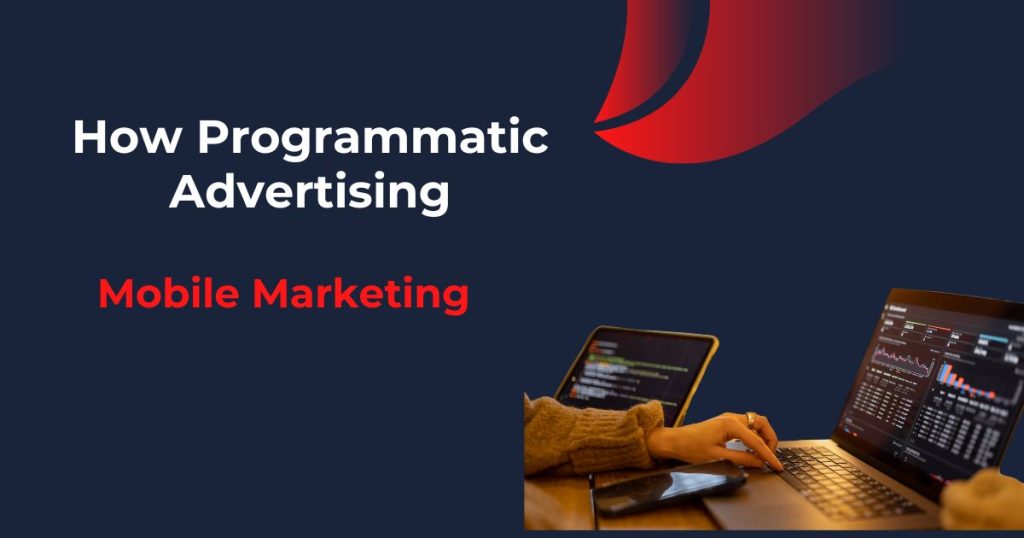How Programmatic Advertising Works in Mobile Marketing

Programmatic advertising is changing how brands and companies reach potential customers with their mobile ads, and mobile marketing has never been more powerful and effective than it is today. For brands looking to leave a lasting mark in mobile, knowing the ins and outs of programmatic advertising is the secret to entering a new stage of growth.
What is Programmatic Advertising?

Programmatic advertising uses machine learning (AI) and real-time bidding (RTB) to allow you to automate the purchase of mobile ads, where ads are placed, and in some cases, the content optimization of your ads. No “haggling or negotiations” are involved; the solution lets marketers reach the right target audience with the best ad placement accuracy.
Rather than casting a wide net of generic ad messages, programmatic advertising uses information — user behavior, location, device type, and preferences for starters — to ensure the right ad gets in front of the right person at the right time.
For mobile advertising, programmatic offers brands access to connect with phone users where they spend the most time … on apps, mobile sites, and social network channels that is.
Why Programmatic Advertising is Crucial for Mobile Marketing

1. Precision Targeting
Mobile devices generate vast amounts of data, making them goldmines for understanding user behavior. Programmatic advertising leverages this data to create hyper-targeted campaigns, using parameters like geolocation, app usage, browsing habits, and even in-app purchases.
Example:
A fitness app can deliver an ad for sportswear targeted specifically at users who track morning workouts on their mobile device.
2. Real-Time Adjustments
Programmatic platforms provide real-time campaign insights. Marketers can modify targeting, bidding, and ad creatives on the go to ensure the best performance without wasting budget on ineffective placements.
3. Cost and Time Efficiency
Through automation, programmatic advertising saves marketers valuable time that would otherwise be spent on manual ad buying while maintaining cost efficiency by targeting only the most relevant users.
4. Access to Premium Ad Inventory
Programmatic advertising gives you access to high-quality inventory, including apps and websites frequented by your target audience. This ensures your ads appear in brand-safe, premium environments.
How Does Programmatic Advertising Work in Mobile Marketing?
Step 1: Set Your Goals
Decide what you want to achieve with your campaign:
- Are you driving app downloads?
- Increasing in-app purchases?
- Boosting mobile site traffic?
Clearly define key performance indicators (KPIs), such as click-through rates (CTR), cost per install (CPI), or conversion rates.
Step 2: Choose the Right Programmatic Platform
There are platforms specifically tailored to mobile marketing, such as:
- Google Ads Display Network for app ads
- MoPub for in-app advertising
- Smaato for accessing global ad inventory
- AdMob by Google for app monetization
Select one that aligns with your audience and campaign goals.
Step 3: Collect and Analyze Data
Data is the backbone of programmatic advertising. Use tools to gather data on:
- User demographics (age, gender, preferences)
- Mobile behavior (apps used, browsing habits)
- Location (for geotargeting opportunities)
Example:
If data shows that a significant portion of your audience engages with specific gaming apps during the evening, your ads can be timed and placed accordingly.
Step 4: Target with Precision
Programmatic advertising excels in advanced targeting methods, such as:
- Contextual ads placing your ads where they match user intent
- Behavioral ads based on past activity (e.g., frequent searches for smartphones)
- Geotargeting for promoting local deals or events near a user’s location
Step 5: Leverage Dynamic Creative Optimization
Dynamic creative optimization (DCO) tailors ad formats, visuals, and messages to align with individual user preferences. For mobile advertising, DCO ensures ads feel personal, resulting in higher engagement and conversion rates.
Example:
An e-commerce app can display a carousel ad featuring the exact product categories a user previously browsed.
Step 6: Retarget Mobile Users
Programmatic advertising in mobile marketing shines when it comes to retargeting. Serve ads to users who have taken certain actions but haven’t converted, such as:
- Abandoned cart retargeting for e-commerce apps
- Retargeting users who installed your app but haven’t made a purchase yet
Step 7: Monitor Performance and Optimize
Use programmatic platforms to track real-time metrics, including:
- Impressions
- Reach
- CTR
- Conversion rates
Adjust your campaign based on insights. For instance, if video ads outperform banners, allocate more budget toward video formats.
Benefits of Programmatic Advertising in Mobile Marketing
Seamless Cross-Device Integration
Programmatic advertising connects user data across devices, ensuring strategic ad placements wherever users engage—from smartphones to tablets to wearables.
Improved User Experience
With personalized ads, users receive content that aligns with their preferences and needs, which reduces ad fatigue and increases engagement.
Scalability
Launch and manage multiple campaigns without additional manual workload. For businesses with large audiences, scalability ensures consistent results.
Overcoming Challenges in Mobile Programmatic Advertising
Challenge 1: Ad Fraud
Solution: Partner with trusted platforms that offer fraud detection and prevention tools, such as MoPub or AdMob.
Challenge 2: Privacy Concerns
Solution: Comply with data privacy regulations like GDPR or CCPA, and use non-intrusive tracking methods like contextual targeting.
Challenge 3: Ad Blockers
Solution: Employ native advertising that integrates seamlessly into content to avoid being blocked.
Taking Mobile Marketing to the Next Level with Programmatic Advertising
Mobile marketing is growing rapidly, and programmatic advertising must the taken into consideration to give your campaign an effective dose. Today, it’s about more than simply getting to people; it’s about engaging with them in thoughtful, tailored campaigns.
Knowing your audience, using programmatic resources, and optimizing with real-time response can dramatically upgrade your mobile marketing.
Looking to get started? Subscribe to our free “Programmatic Advertising Beginner’s Guide” and find out how you could be using programmatic to its full potential on your mobile campaigns.





